Table Of Contents
- 1 What is Salesforce Testing?
- 2 Why Salesforce Testing is Important For Your Business
- 3 Types of Salesforce Testing
- 4 Should You Automate Your Tests For Salesforce?
- 5 Benefits of Automating Salesforce Test
- 6 Recommendations for Automating Salesforce Tests
- 7 Main Challenges Of Salesforce Application Testing
- 8 Best Practices for Salesforce Application Testing
- 9 Salesforce Testing Requirements
- 10 How To Test a Salesforce Application Using Testsigma [Step-by-Step Process]
- 11 Why Testsigma for Salesforce Test Automation?
- 12 Testsigma Salesforce Application Testing Capabilities
- 13 Summary
What is Salesforce Testing?
Salesforce testing is the process of evaluating and verifying the functionality, performance, and quality of applications. It involves conducting various tests to ensure that the app implementation meets the desired requirements, works as intended, and delivers a seamless user experience. It is also referred to as SFDC testing.
Testsigma makes automated testing easy and efficient for every Salesforce user. You do not have to spend hours creating code scripts to test your applications. With Testsigma, you can use plain English commands to create automated tests without coding.
Why Salesforce Testing is Important for Your Business
- QAs can identify bugs in an early stage before they slip through production. It helps avoid the need for costly rework, reduces production issues, and minimizes potential business risks.
- Allows testers to check if the application is working as intended or not.
- It helps improve the overall software quality and user experience.
- It ensures that customizations work correctly and align with the desired business requirements.
- It helps validate the accuracy, completeness, and consistency of data within Salesforce, ensuring the integrity and reliability of the information.
- It validates that the third-party integration with Salesforce is working correctly.
Types of Salesforce Testing
Native Testing
Native testing utilizes the existing testing options provided within the framework. But this focuses mainly on unit tests. Though unit testing is also highly important, it does not actually show the user impact. There are other testing types, like UI testing, integration testing and UAT, that focus on user impact.
Also Read: Salesforce Regression Testing
Manual Testing
In manual testing, the testers manually set up, execute, and analyze the tests. Different types of testing, like functional, API , and integration testing, are performed manually. Though manual testing is versatile, it lacks scalability as it relies on repetitive tasks performed by testers manually, making it inefficient and error-prone.
Also Read: Salesforce Integration Testing
Exploratory Testing
Exploratory testing is where the tester simultaneously learns, explores, and tests the application. Testers use their domain knowledge and experience to uncover potential issues, validate assumptions, and assess the overall quality of the application. The goal is to discover defects that can not be detected using other traditional methods. This is more like a creative testing technique where testers have to think out of the box to discover potential risks, if any.
Automated Testing
Automated testing can deliver reliable and scalable results. Though Salesforce comes with a lot of challenges, like shadow DOM, heavy tree structure, and dynamic elements, there are a few Salesforce automation testing tools that offer robust support for testing.
Should You Automate Your Tests for Salesforce?
Yes, automating tests for Salesforce applications is highly recommended. Testing is automated to avoid repetitive and error-prone manual testing activities. Also, it helps save time, cost, and effort. You can automate SFDC testing using a tool like Testsigma to create reliable and stable applications.
Benefits of Automating Salesforce Test
Salesforce test automation offers several benefits that can significantly enhance the testing process and improve overall efficiency and effectiveness. Some of the key benefits include:
Save Time and Effort: Automated tests can execute test cases much faster than manual testing. This helps save time and effort, allowing QAs to focus on other critical tasks and increasing overall productivity.
Improved Test Coverage: With automation, you can execute a larger number of test cases in less time and achieve wide test coverage. It helps cover a broad range of test scenarios, including both positive and negative tests and complex workflows, ensuring comprehensive validation of the application.
High Test Accuracy: Automated tests execute test cases consistently without human errors. This leads to more accurate and reliable test results, eliminating inconsistencies that may occur during manual testing.
Faster Feedback Cycles: Automated tests provide rapid feedback on the quality of the application. This enables faster development cycles and faster time to market. Testsigma makes your testing 10x faster and helps ship products faster.
Also Read: Salesforce Test Cases
Recommendations for Automating Salesforce Tests
Though there are various automation tools, finding the best can be a bit challenging. Key factors when you look for a tool:
Ease of Use: The tool should be easy to use so anyone on the team can access it. It accelerates the testing process because everyone in the team will be aligned with the process.
Low-Code Approach: Use a low code automation tool so you don’t have to spend time writing complex test scripts. Check here – Salesforce Testing Low Code Platform
CI/CD Integrations: Pick a tool that easily integrates with various third-party applications, like CI/CD tools, project management, collaboration, and bug tracking tools.
Salesforce-Specific Capabilities: Ensure that the tool has specific features and capabilities designed for this testing. It should support testing of Salesforce-specific components like Apex code, Visualforce pages, Lightning components, workflows, and integrations.
Main Challenges of Salesforce Application Testing
- As this app has different types of users, writing test cases for various roles, settings, and features can be challenging.
- Testing advanced components and features of app, like Visualforce or Service Cloud Console, can be difficult.
- Some of the standard functionalities can not be removed even if they are not in use.
- Graphical User Interface tests do not work when switched to the test environment.
- Salesforce is a dynamic environment, so finding IDs can be quite tedious.
- This app has frequent updates and releases, so you will have to update and maintain test cases after every update.
- Testers have to run tests across different test environments.
Best Practices for Salesforce Application Testing
- Start testing in the early stages. It will help increase test coverage and perform different tests.
- Perform tests with real user profiles.
- Test both positive and negative scenarios (valid and invalid data).
- Developers must perform unit testing before sending the code for testing. This helps fix bugs in the earlier stages and saves time.
- Right test automation tools can help improve the quality of testing.
- A walkthrough of the test cases with developers and stakeholders will help in understanding the requirements better.
- Execute different types of testing like Salesforce API testing, UI testing, integration testing, cross-browser testing, UAT testing, etc.
- Update the test cases whenever there is an update in the requirement.
- Create and test user roles using Workflows.
Also Read: Salesforce UI Testing
Salesforce Testing Requirements
Like any other web application testing, testing in Salesforce requires QAs to have a clear understanding of the Salesforce architecture, customizations, integrations, and how they interact with built-in Salesforce features. So, developers and testers must have clear communication of the customized features as the user scenarios, test cases, and test scripts will be based on these interactions.
The testing will be performed in the Sandbox environment, and then it will be deployed in the production environment. Testsigma makes your SFDC testing 10x faster and more efficient with a combination of codeless approach and AI-driven testing.
How to Test a Salesforce Application Using Testsigma [step-by-step Process]
Let’s take a quick look at how Testsigma makes this testing accessible for technical and non-technical members,
1. Sign up/Log in
Create a free Testsigma account. Log in to your Testsigma account if you’re an existing user.
2. Create a Salesforce project
Create a new project for testing and add the project details.
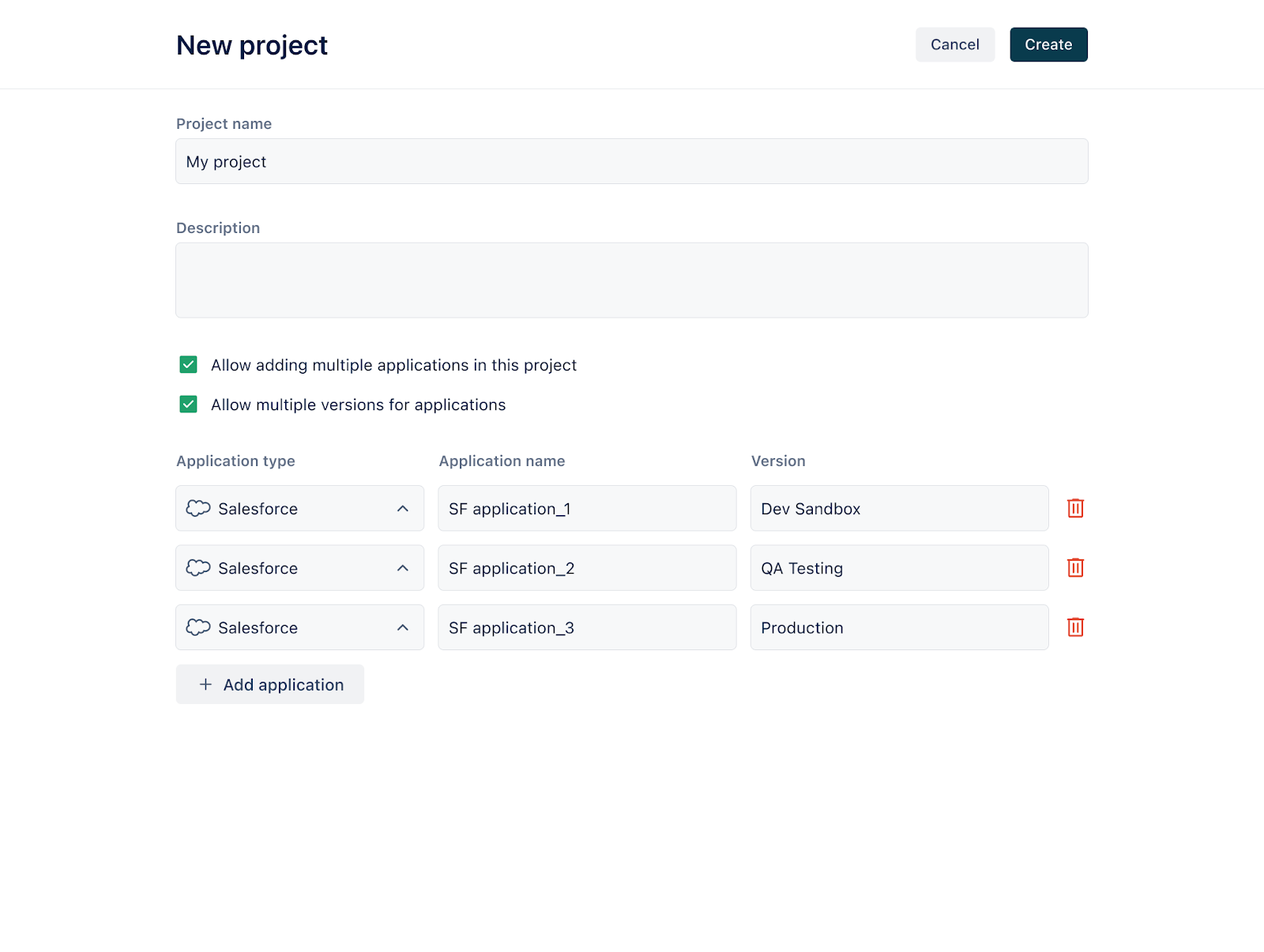
3. Sync your Salesforce instance with Testsigma
Establish a connection between your Salesforce application and Testsigma using the Metadata connection.
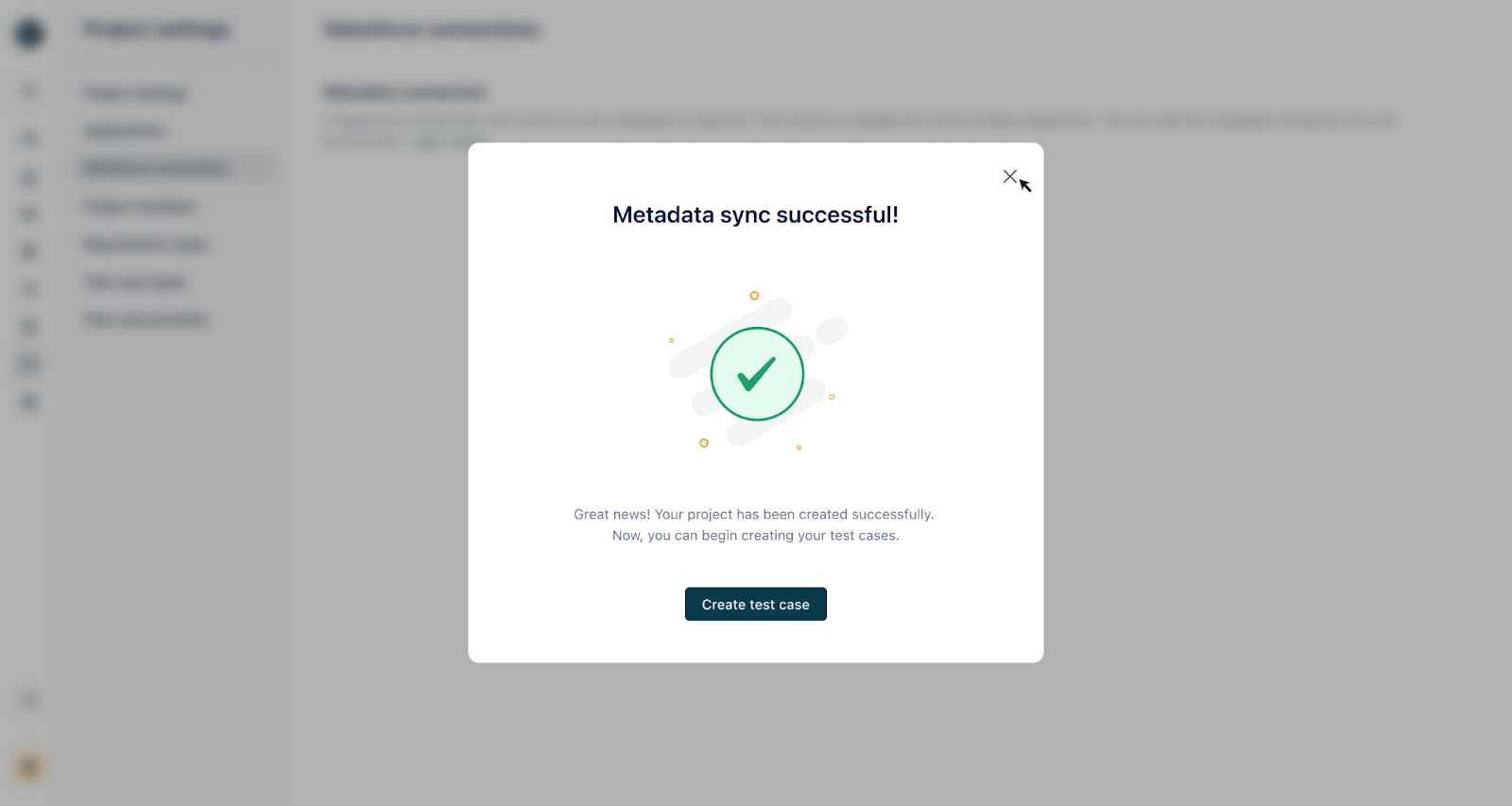
4. Create test cases
Use the Recorder to record user interactions and run them as automated tests or simply create tests in plain English using NLP-driven testing.
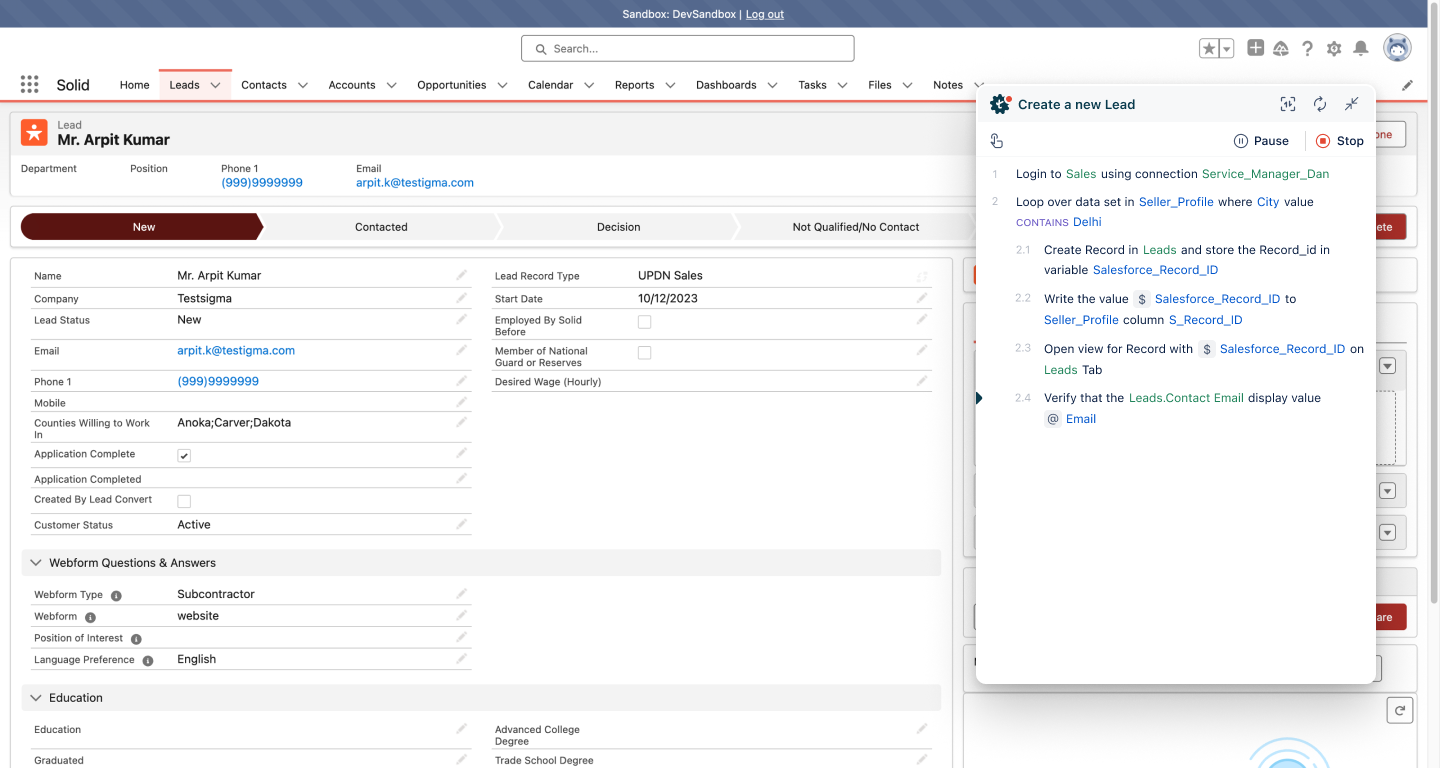
5. Execute tests
After the test creation is done, execute them.
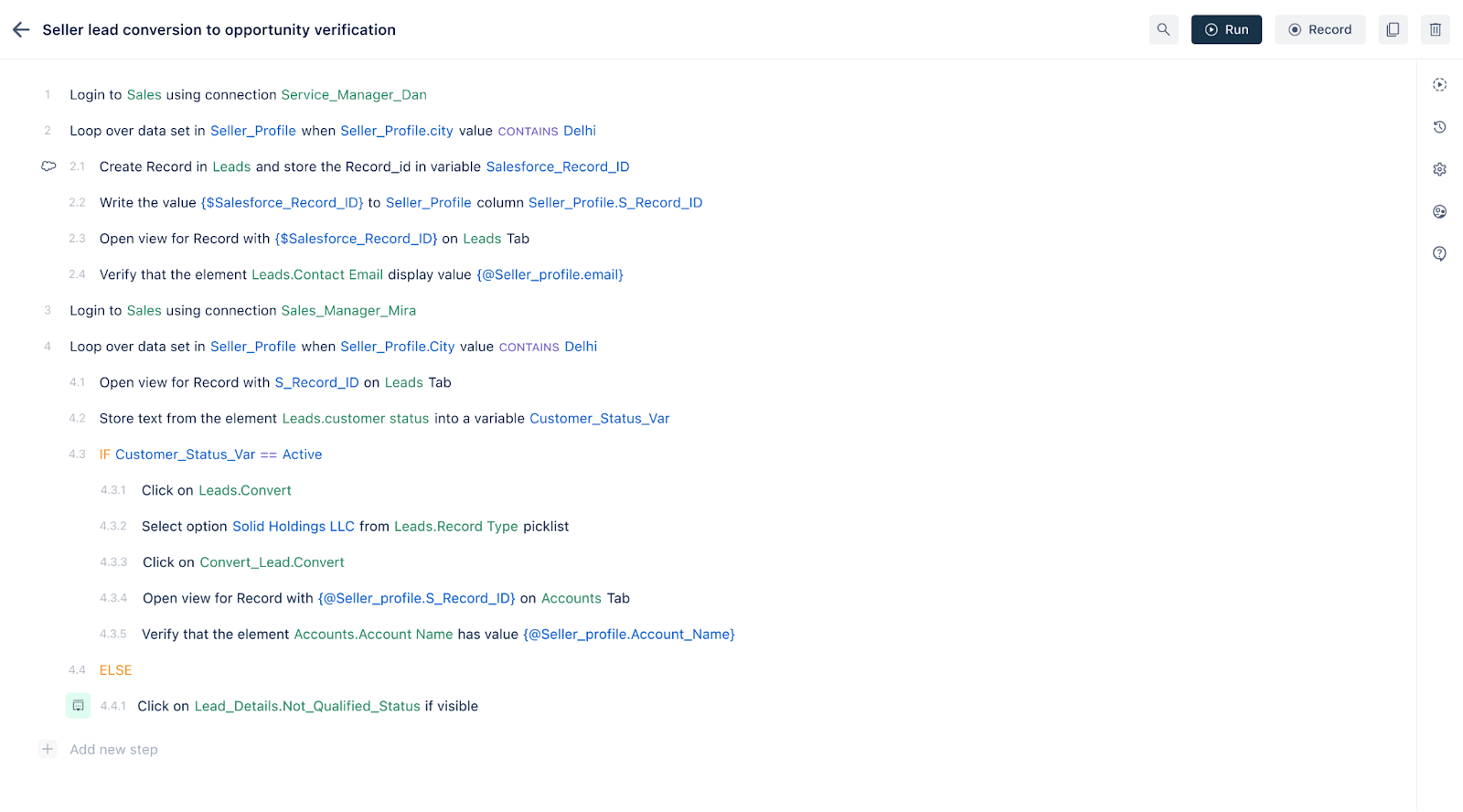
6. Analyze the test reports
Once the test run is complete, you will get detailed test reports. Analyze and share it with the developers. If bugs are fixed, rerun the tests to ensure the application is bug-free. If not, repeat the steps.
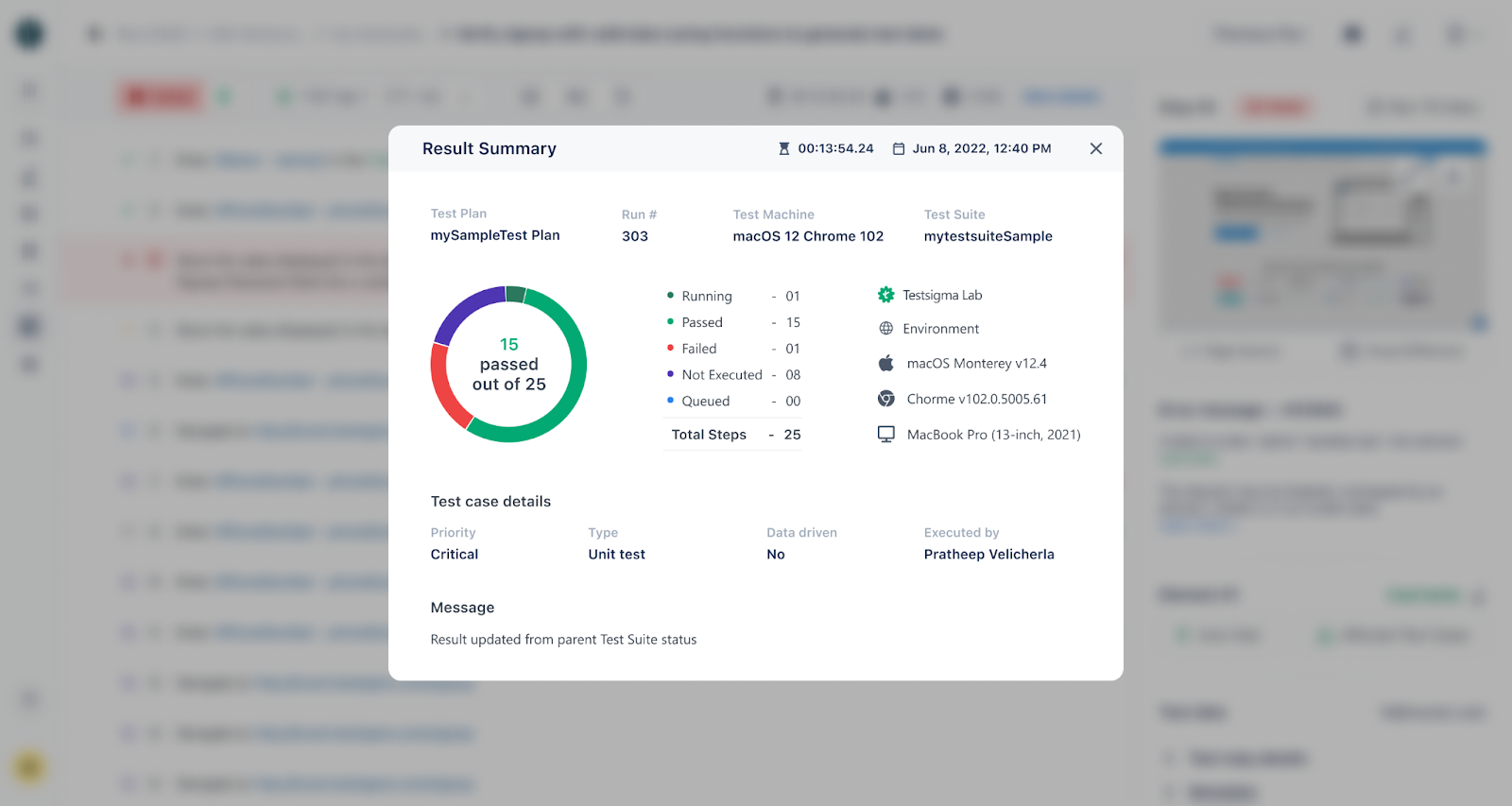
Sign up for free and check the full product demo available on the platform for comprehensive Salesforce testing.
Why Testsigma for Salesforce Test Automation?
Zero Setup Time
Quickly start test automation without any installation or setup process. Create your Testsigma account in seconds on the cloud.
Zero Coding Required
No coding is required. Automate even complex Salesforce scenarios in plain English using low-code techniques.
Actionable Insights
Get detailed real-time test reports after every test run. Easily export and share them with developers for quick bug fixing.
GenAI-Powered Testing
Get smart and intelligent test suggestions from prompts, user stories, or plain English
Zero Maintenance Overhead
AI-powered auto-healing capability adapts your test cases to any UI changes, reducing your test maintenance efforts to 70%
Test across Environments
Automate testing across Salesforce Developer Sandbox – Developer Pro, Partial Copy, and Full sandbox
Testsigma Salesforce Application Testing Capabilities
| Capabilities | Testsigma |
| Installation & Use | Sign up for free and start using on the Cloud |
| Supported OS | Windows, macOS, and Linux |
| Application Types Supported | Salesforce, SAP, Web, Mobile, Desktop, Mobile Web, and API apps |
| Test Case Creation | Zero coding required. Use plain English to create tests |
| Parallel Testing | Run multiple tests parallelly across different Salesforce environments simultaneously |
| Real Device Cloud | 3000+ Real devices, browsers, and OS combinations |
| Record & Playback | Available with advanced features |
| Integrations | With Bug Reporting, Product Management, CI/CD, Test Labs, and Collaboration Platforms |
Summary
Salesforce testing is not a one-time event but an ongoing journey. As the platform evolves, new features are introduced, and business requirements change, it’s crucial to stay up-to-date and adapt your testing strategies accordingly. Embrace automation, leverage the power of continuous integration, and embrace agile methodologies to keep pace with the ever-changing Salesforce ecosystem.
Manual Salesforce testing can be challenging and complex as it requires more time and a team of experienced testers to perform testing. But Salesforce testing can be automated quickly and efficiently using powerful test automation tools like Testsigma, Accelq, and Katalon.
It depends on the type of automation tool you use for testing Salesforce. You can use both code-based and codeless test automation tools for automating Salesforce testing. Using low-code automation tools like Testsigma, you can automate complex Salesforce tests as plain English statements using the NLPs. On the contrary, if you use a code-based test platform like Selenium for Salesforce testing, then you will have to write code-based automation scripts.
